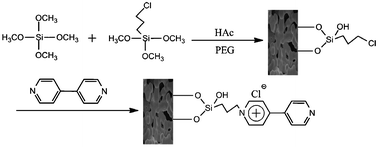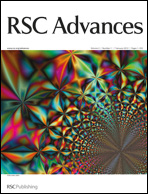Preparation and characterization of dipyridine modified hybrid-silica monolithic column for mixed-mode capillary electrochromatography†
Abstract
A new mixed-mode organic–silica hybrid monolithic column for capillary electrochromatography was synthesized via a sol–gel process and a following post-modification with 4,4′-dipyridine. Characterization by SEM shows that the hybrid monolith has homogenous macroporous morphology and it is well attached to the inner wall of the capillary. A stable and reversed electroosmotic flow (EOF) was generated at acidic pH due to the pyridinium groups on the surface of the stationary phase. The column performance was evaluated by separating various kinds of compounds, such as polycyclic aromatic hydrocarbons (PAHs), alkylbenzenes, phenols, inorganic anions and organic acids. Multiple retention mechanisms including hydrophobic, π–π and anion-exchange interactions were exhibited at separation of the analytes. The monolithic stationary phase exhibited reversed-phase chromatographic behavior toward neutral solutes. Meanwhile, inorganic anions and organic acids can be separated by the mixed-mode mechanism comprising electrophoresis, hydrophobic and anion-exchange interactions. Good performance and repeatability showed that this new hybrid column can be used in the analysis of various compounds with great prospects.


 Please wait while we load your content...
Please wait while we load your content...